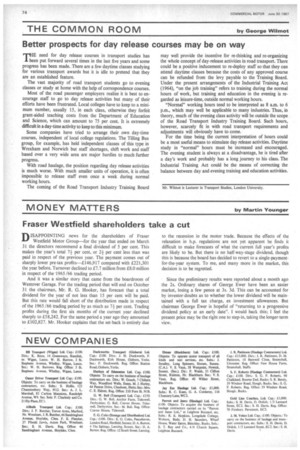THE COMMON ROOM
Page 76

If you've noticed an error in this article please click here to report it so we can fix it.
by George Wilmot
Better prospects for day release courses may be on way
E need for day release courses in transport studies has been put forward several times in the last five years and some progress has been made. There are a few daytime classes studying for various transport awards but it is idle to pretend that they are an established feature.
The vast majority of road transport students go to evening classes or study at home with the help of correspondence courses.
Most of the road passenger employers realize it is best to encourage staff to go to day release activities but many of their efforts have been frustrated. Local colleges have to keep to a minimum number, usually 15, in each class, otherwise they forfeit grant-aided teaching costs from the Department of Education and Science, which can amount to 75 per cent. It is extremely difficult in a day-time activity to keep to this minimum.
Some companies have tried to arrange their own day-time courses, independent of local college regulations. The Tilling Bus group, for example, has held independent classes of this type in Wrexham and Norwich but staff shortages, shift work and staff based over a very wide area are major hurdles to much further progress.
With road haulage, the position regarding day release activities is much worse. With much smaller units of operation, it is often impossible to release staff even once a week during normal working hours.
The coming of the Road Transport Industry Training Board may well provide the incentive for re-thinking and re-organizing the whole concept of day-release activities in road transport. There could be a positive inducement to re-deploy staff so that they can attend daytime classes because the costs of any approved course can be refunded from the levy payable to the Training Board. Under the present arrangements of the Industrial Training Act (1964), "on the job training" refers to training during the normal hours of work, but training and education in the evening is regarded as leisure-time, outside normal working hours.
"Normal" working hours tend to be interpreted as 8 a.m. to 6 p.m., which may well be applicable to many industries. Thus, in theory, much of the evening class activity will be outside the scope of the Road Transport Industry Training Board. Such hours, however, scarcely fit in with road transport requirements and adjustments will obviously have to come.
For the time being the current interpretation of hours could be a most useful means to stimulate day release activities. Daytime study in "normal" hours must be increased and encouraged. The evening student is always at a disadvantage, he is tired after a day's work and probably has a long journey to his class. The Industrial Training Act could be the means of correcting the balance between day and evening training and education activities.
Mr. Wilmot is Lecturer in Transport Studies, London University.
























































































































